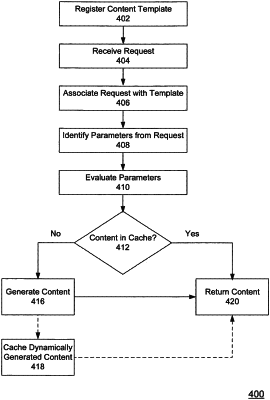| CPC G06F 16/972 (2019.01) [G06F 16/93 (2019.01); G06F 16/9574 (2019.01); G06F 16/958 (2019.01); H04L 67/02 (2013.01)] | 18 Claims |

|
1. A method for provisioning content, comprising:
receiving from a client device a request for content at a content delivery system;
responsive to the request, searching, by the content delivery system, a server cache for first content which matches, or which most closely matches, the requested content using a look-up mechanism employing a hashed key computed using a system attribute determined from a previous request for content, wherein the system attribute is one or more of a display format, a channel, a site, an item, a locale, a user, a group, or a class;
based on the first content not being found in the server cache, obtaining the first content which matches the requested content from a content management system;
sending the obtained first content to the client device;
storing, by the content delivery system, the first content in the server cache, the first content stored in the server cache in conjunction with caching parameters and associated with parameters in the request for content, the first content stored in the server cache along with metadata that includes attributes pertaining to a template that corresponds to the first content, wherein a search of the server cache for the first content comprises comparing the parameters in the request for content to the caching parameters stored in the server cache in conjunction with the first content wherein the first content is a page fragment;
receiving a notification that second content has been altered at the content management system managing the second content, the notification based on data related to one or more of the caching parameters stored in the cache in conjunction with the first content wherein the notification includes an identifier for the first content or second content or a dependency of the first content or second content; and
in response to receiving the notification that the second content has been altered at the content management system:
obtaining the second content as stored at the content management system, and
replacing the first content in the server cache with third content, the third content based
on the obtained second content, wherein the third content is a page fragment.
|